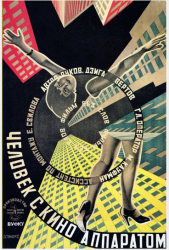On the sixth day of the Milwaukee Film Festival, a crowd of ticket-holders lined the rainy streets outside the Oriental

Theater waiting to watch the screening of “The Man with a Movie Camera.” This silent, Russian documentary is film-stream madness as director Dziga Vertov blends film strips together, slows down and speeds up the film reel and cuts certain frames out only to reattach them to different strips. These effects result in a psychedelic documentary proving decades ahead of its time, having premiered in 1929. Enhancing the experience, this particular screening of “The Man with a Movie Camera” was accompanied by the Alloy Orchestra of Cambridge, Mass. The critically-acclaimed orchestra performed its original film-long soundtrack live in the theater, an event that happens only a few times a year.
The soundtrack performed by Alloy’s Orchestra gives the film emotional context. The panicked violins made me frantic as I watched hundreds of people run around on screen and the slow tick of the cymbal gave me the creeps as I watched the film reel itself slow down to a complete halt, only to take a long pause on a still-image of a woman’s smoldering stare.
The appropriateness of Alloy Orchestra’s instruments paired with Vertov’s film style is a masterpiece within itself. Alloy Orchestra is able to influence the audience so effectively because of unconventional playback techniques that Vertov has created. Not only does Alloy Orchestra build anticipation by filling the theater with a whirlwind of manic percussion styles, Vertov at times slows down and speeds up the film playback at crucial parts of the documentary, making the audience wait in awe for the last part of a magic trick and speed through what seems like hours of footage within minutes.
“The Man with a Movie Camera” redefines the probable stages of documentaries. Rather than following a timeline, a single person or idea, Vertov combines it all with an effortless fluidity that makes all of the film’s chaos seem orderly. It makes an audience member think, “Well, of course a scene of a man anticipating a train collision is being rapidly alternated with a woman waking up in the morning.” Alloy Orchestra aids this notion, the audience is encompassed by the steady refrain that resounds throughout the entirety of the film, leaving film-goers one-hundred and twenty minutes later, wondering how the show is over already.

